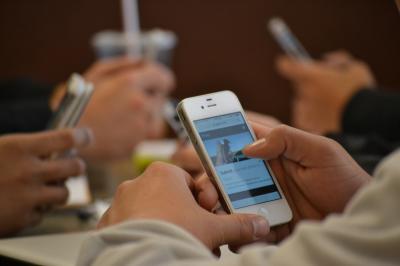Smartphones are everywhere, and they may tell something about you that you didn't realize could be told.
When we touch things we give it our 'germs' and that knowledge could tell researchers something about our personal microbial world. Our phones can be biological and environmental sensors.
To test our biological connection with phones, University of Oregon researchers sequenced microbes from the dominant-hand index fingers and thumbs of 17 subjects and from the touchscreens of their smartphones, during a recent Robert Wood Johnson Foundation workshop in Princeton, New Jersey.

Our cell phones reflect the personal microbial world of their owners with potential implications for their use as bacterial and environmental sensors. Credit: James Meadow
The study found smartphones closely resembled the microbiome sampled from their owner's finger, with 82 percent of the most common bacteria on participants' fingers also found on their phones.
Interestingly, women were found to be more closely connected, microbiologically speaking, to their phones than were men. Although men and women were both statistically similar to their own phones, the relationship was stronger for women than for men. The findings appear in the June 24 issue of the online open-access, peer-reviewed journal PeerJ.
The most commonly found bacteria were from three genera that are ubiquitous on and in humans: Streptococcus, which is commonly found in the mouth, and Staphylococcus and Corynebacterium, both common skin residents.
The analyses, utilizing short-read 16S sequencing, focused on categorizing whole microbial communities rather than identifying pathogens. The findings emerged from sequences representing more than 7,000 different types of bacteria found in the 51 samples taken from fingers and phones.
"The sample size was small, but the findings, while intuitive, were revealing," said lead author James F. Meadow, a postdoctoral researcher in the Biology and the Built Environment Center at the University of Oregon.
"This project was a proof-of-concept to see if our favorite and most closely held possessions microbially resemble us. We are ultimately interested in the possibility of using personal effects as a non-invasive way to monitor our health and our contact with the surrounding environment," he said.
Future uses could include real-time sequencing technology to screen the smartphones of health-care workers and hospital visitors, rather than the people themselves, for possible exposure to pathogens that could be carried into or out of a medical facility. Also, phones are ubiquitous and come into direct contact with so much of a person's environment that they might also be valuable for analyzing exposure to "biological threats or unusual sources of environmental microbes that don't necessarily end up integrated into our human microbiome," researchers noted.
The findings also present opportunities for future scientific use, as phones could be used for easy and non-invasive sampling in large-scale microbial studies. The next step is to expand this research to develop and test predictions about the spread of microbiota among people and over time, particularly in health care facilities where hospital acquired infections impact about 1 in every 20 patients.




Comments